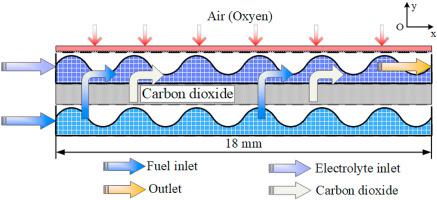Journal of Cleaner Production ( IF 11.1 ) Pub Date : 2020-11-19 , DOI: 10.1016/j.jclepro.2020.125211 Tiancheng Ouyang , Jingxian Chen , Jie Lu , Peihang Xu , Chunlan Mo

|
To cope with the weaknesses of high pollution emission and poor security in traditional lead acid and lithium-ion batteries, microfluidic fuel cell plays a significant role in energy transformation instrument of high efficiency and low pollution, with potential applications in portable electronic device. For the energy conservation purpose, it is considered as an ideal power supply with prolonged work time and substantial power output. The two-phase flow and vibration effects are the two important factors to be considered in practical fuel cell applications because the gas/liquid two-phase flow is a non-negligible threat in acidic fuel cells. In this study, a two-phase flow computational model is developed to investigate the vibration effects on cell characteristics based on a multi-physics coupling process. The model accuracy is validated with the previous experiment. Major results demonstrate that: (1) Vibration intensity and frequency have negative impacts on cell performance owing to the severe fuel crossover and delayed gas phase discharge; (2) Increasing the feed liquid flow rate is a resultful approach to resist the vibration effects, alleviate fuel crossover, and improve the current and power outputs. However, these are achieved at the expense of fuel utilisation and exergy efficiency; (3) Increased contact angle also plays the positive part in decreasing gas phase fraction; (4) The cell performance depends strongly on vibration intensity, and improving the anti-seismic performance of MFC mainly increases the ability of the cell to resist vibration intensity. In conclusion, the fuel cell is a clean effective power supply device for the emission reduction and sustainable development, and the work lays the foundation for improving the shock-absorbing design and microfluidic fuel cell performance. This technology is generally applied to the portable electronic equipment, the analysis reveals the flow state of cell, and this research method is used for reference to performance analysis of other types of fuel cells.
中文翻译:

基于新型两相流模型的微流控燃料电池能量,能值和抗振动评估
为了解决传统铅酸和锂离子电池中高污染排放和安全性差的缺点,微流控燃料电池在高效低污染的能量转换仪器中起着重要的作用,在便携式电子设备中具有潜在的应用前景。出于节能目的,它被认为是具有较长工作时间和大量功率输出的理想电源。两相流和振动效应是实际燃料电池应用中要考虑的两个重要因素,因为气/液两相流在酸性燃料电池中是不可忽略的威胁。在这项研究中,建立了两相流计算模型,以研究基于多物理场耦合过程的振动对电池特性的影响。模型精度已通过先前的实验验证。主要研究结果表明:(1)振动强度和频率由于严重的燃料交叉和延迟的气相放电而对电池性能产生负面影响;(2)提高进料流量是抵抗振动影响,减轻燃料交叉并改善电流和功率输出的有效方法。但是,这些目标是以燃料利用和火用效率为代价的。(3)增大的接触角在减少气相分数方面也起着积极的作用;(4)电池性能在很大程度上取决于振动强度,而提高MFC的抗震性能主要是提高电池抵抗振动强度的能力。结论,该燃料电池是一种清洁有效的清洁能源供应装置,可实现减排和可持续发展,为改善减震设计和微流体燃料电池性能奠定了基础。该技术普遍应用于便携式电子设备,分析揭示了电池的流动状态,该研究方法可为其他类型燃料电池的性能分析提供参考。



























 京公网安备 11010802027423号
京公网安备 11010802027423号